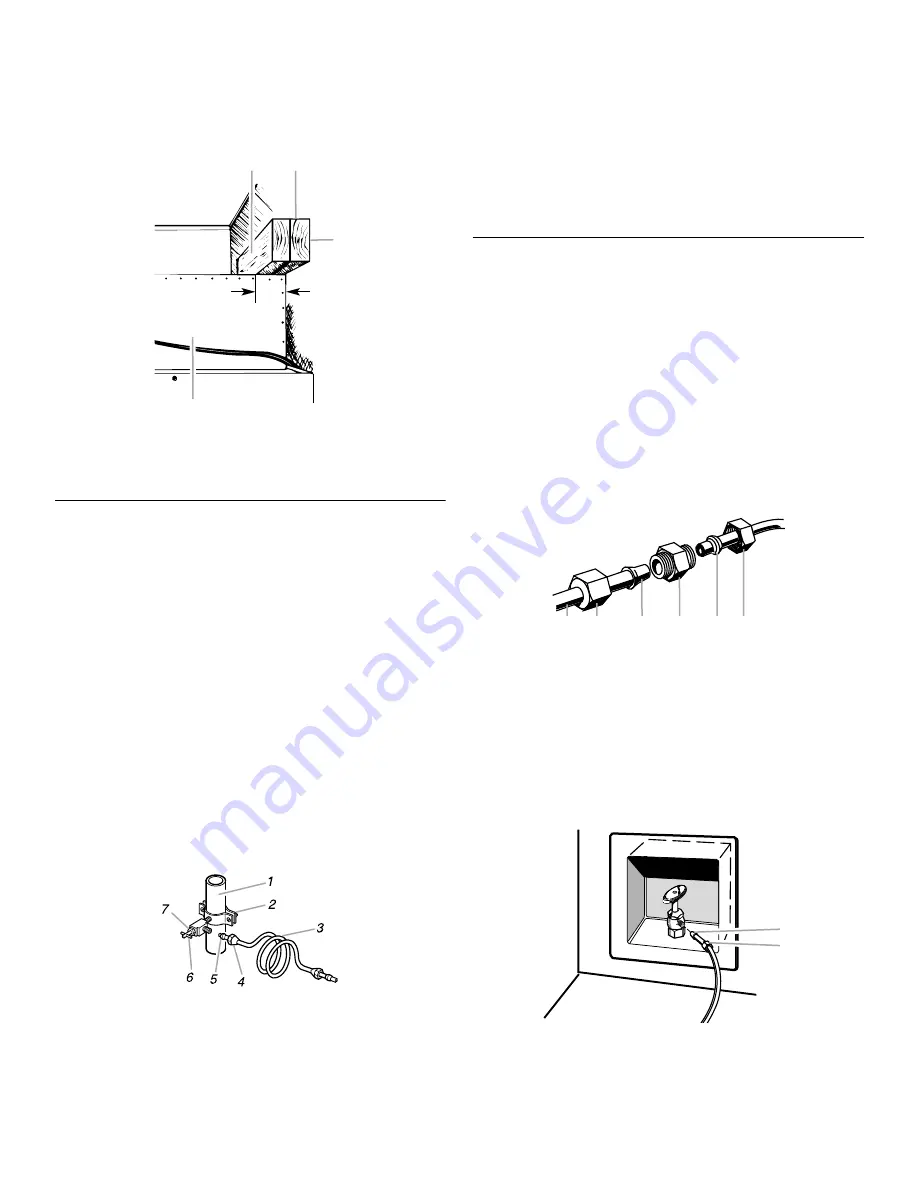
14
2. Securely attach one or two 2 in. x 4 in. x 32 in.
(5 cm x 10 cm x 81 cm) wood boards to wall studs behind
refrigerator. Use 6 - #8 x 3 in. (7.6 mm) (or longer) wood
screws.The wood screws must be screwed into the studs at
least 1½ in. (3.8 cm). The board(s) must overlap the
compressor cover.
1. Center board
¹⁄₄
in. (6 mm) max. above refrigerator
2. Two, 2 in. x 4 in. x 32 in. (5 cm x 10 cm x 81 cm) boards
3. Attach to studs with 6 -#8 x 3 in. (7.6 cm) screws
4. Compressor cover
Install New Water Line
(if required)
Tools required: Standard screwdriver,
⁷⁄₁₆
in. and
¹⁄₂
in. open-end
wrenches or two adjustable wrenches,
¹⁄₄
in. nut driver and drill
bit, hand drill or electric drill (properly grounded).
1. Unplug refrigerator or disconnect power.
2. Turn OFF main water supply. Turn ON nearest faucet long
enough to clear line of water.
3. Find a ½ in. to 1
¹⁄₄
in. (12.7 mm to 3.18 cm) vertical COLD
water pipe near the refrigerator.
NOTE: Horizontal pipe will work, but drill on the top side of
the pipe, not the bottom. This will help keep water away from
the drill and normal sediment from collecting in the valve.
4. Determine the length of copper tubing you need. Measure
from the connection on the lower left rear of refrigerator to the
water pipe. Add 7 ft. (2.1 m) to allow for cleaning. Use
¹⁄₄
in.
(6.35 mm) O.D. (outside diameter) copper tubing. Be sure
both ends of copper tubing are cut square.
5. Using a grounded drill, drill a
¹⁄₄
in. hole in the cold water pipe
you have selected.
6. Fasten the shutoff valve to the cold water pipe with the pipe
clamp. Be sure the outlet end is solidly in the
¹⁄₄
in. drilled hole
in the water pipe and that the washer is under the pipe clamp.
Tighten the packing nut. Tighten the pipe clamp screws
carefully and evenly so washer makes a watertight seal. Do
not overtighten or you may crush the copper tubing.
7. Slip the compression sleeve and compression nut on the
copper tubing as shown. Insert the end of the tubing into the
outlet end squarely as far as it will go. Screw compression nut
onto outlet end with adjustable wrench. Do not overtighten.
8. Place the free end of the tubing in a container or sink, and
turn ON the main water supply. Flush the tubing until water is
clear. Turn OFF the shutoff valve on the water pipe. Coil the
copper tubing.
9. Route copper tubing to the refrigerator.
Connect Water Line to Refrigerator
1. Remove the shipping tape from gray, coiled water tubing on
the rear of the refrigerator.
2. Before attaching copper tubing to refrigerator, flush at least 2
quarts (1.9 L) of water through the copper tubing and into a
bucket to get rid of any particles in the water line.
3. Check for leaks around the saddle valve. Do not overtighten
clamp or sleeve. This will crush copper tubing.
4. Make connection to refrigerator.
Style 1 - Connecting to a Water Line:
Additional Parts Needed: Coupling, ferrule and nut.
Slide the purchased nut then the purchased ferrule onto the
tubing. Push the tubing into the purchased coupling as far as it
will go. Slide the nut and ferrule forward. Tighten the nut by hand.
Then tighten it with a wrench two more turns. Do not overtighten.
Style 2 - Connecting to a Water Valve:
NOTE: The water shutoff should be located in the base cabinet
on either side of the refrigerator. The right-hand side is
recommended. The access hole through the right cabinet must
be within
¹⁄₂
in. (12.7 mm) of rear wall.
Push the bulb end of the tubing into the water valve as far as it
will go. Slide the nut forward and finger tighten. Tighten the nut
by hand. Then tighten it with a wrench two more turns. Do not
overtighten
1. Bulb
2. Nut (provided)
5. Turn shutoff valve ON. Check for leaks. Tighten any nuts or
connections (including connections at the valve) that leak.
1. Cold Water Pipe
2. Pipe Clamp
3. Copper Tubing
4. Compression Nut
5. Compression Sleeve
6. Shutoff Valve
7. Packing Nut
2
1
3
2" (5 cm)
4
1. Line to Refrigerator
2. Nut (provided)
3. Bulb
4. Coupling (purchased)
5. Ferrule (purchased)
6. Nut (purchased)
1
2
3
4
5
6
1
2















































